© 2013 The Texas Lawbook.
By Patricia Baldwin
Lifestyle Writer for The Texas Lawbook
Attorney Steve Carlin is an unabashed early adopter (make that bleeding edge early adopter). He’s even hoping for the time he can invoke the Star Trek transporter phrase of “Beam me up, Scotty” to return to his office.
Until then, however, the managing shareholder of Greenberg Traurig in Dallas is one of many Texas lawyers who are using a seemingly endless choice of apps and gadgets – high tech and low tech – to stretch and enhance business productivity as well as personal fulfillment in today’s 24/7 life cycle.
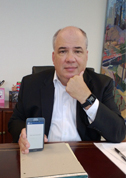
Instead of “paper or plastic,” the question of the day is “Apple or Android?” The Apple App Store offers some 800,000 apps for the iPhone and 300,000 for the iPad, while Google Play features more than 500,000 games and apps. So, go pick, but also be aware of challenges as the legal profession adapts to new technology. As a law student might text: Could b good, could b bad.
“I’m a gadget person. I try a lot of apps,” says Carlin, who uses a Galaxy Note II with a 5.5-inch screen as his cell phone. “I can actually read PDF attachments without going blind or getting carpal tunnel syndrome from having to scroll from side to side incessantly.”
Yet when encouraged to narrow his conversation to a top-two list, he finds the task easy. 1. He’s a great fan of his Pebble smart watch. 2. He and his attorney wife, Shelley, manage their busy lives as parents to a 13-year-old son via the Couple app, advertised as “an app for two.”
Carlin explains, “My general philosophy is that I get notified of everything all the time so I don’t get meaningful notification of anything.”
He customized the Pebble watch to let him know of specific text messages and personal Gmail – when he is within about 30 feet of his phone. In particular, that means the dinner table and the courtroom.
Currently, the Pebble connects to iPhone and Android smartphones using Bluetooth and alerts the user to personally selected incoming calls, emails and messages with a silent vibration.
Carlin touts the long battery life (about a week) and his customized watch face with the time, date and weather. He only has to glance at his watch in court to see important communications.
Carlin says the watch keeps him focused at the office and reduces the “clutter” when he’s home. As for the Couple app, it’s simple, secure, encrypted and password protected. “I know I am only communicating with my wife,” Carlin says. (Ah, just think: no more of those accidental and embarrassing “reply all” responses.)
Speaking of favorite apps, Matt Strock, partner at Vinson & Elkins in Houston, says he uses iAnnotate PDF more than any other app. He can receive a document via email and then markup changes, highlight passages, type notes, provide commentary and more. There’s even a pencil feature in case he wants to circle something.
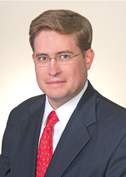
Goodbye No. 2 editing pencils. Just think of the app as a more versatile version of Track Changes in iPad format.
“It’s about flexibility and portability of your practice,” Strock says.
These days, he adds, a lawyer can no longer sit in the office all day. Technology gives Strock the freedom to spend more time with clients. Staying connected, he says, is “critical” in today’s world. And he is “absolutely more efficient” than just a couple of years ago.
The legal profession was in the mind of Greg Smith and his designers in the creation of Privus Mobile. The president and CEO of Allen-based Accudata Technologies notes that attorneys are known for getting a lot of calls, many times from unknown numbers. Privus Mobile’s free caller ID and caller lookup smartphone app allows users to see the name of the individual who is calling, whether the caller is in the user’s contact list or not.
Smith says Privus Mobile works like caller ID for the home – “only better.” He says it is 95 percent accurate and also identifies texters by name, again, even when they are not in the user’s contact list.
Privus Mobile also offers Privus Caller ID. Equipped with all Privus Mobile functionality, including Caller ID, Text ID, Voice Cue and Caller Lookup, Privus Caller ID audibly announces the name of the contact calling or texting a driver’s cell phone, even if a contact is not listed in the phone’s contact list.
In San Antonio, two colleagues separately called Mark Unger of the Unger Law Firm “our Bar Association techie.” He acknowledges he’s “obsessed,” which has led to his being in demand for local, state and national panels about technology.
Overall, he says he thinks the legal community is “adapting” to changes brought by technology.
“Paperless is a huge trend,” he adds, noting the practice of law is being impacted by time and billing programs, cloud practice management systems and some “fun” gadgets and technology, such as the iWatch, the portable Pico projector and Apple TV.
Still, he predicts privacy challenges and various “disruptions” to the practice of law as technology forces standardization discussions at Bar gatherings, and the profession progresses toward mandatory e-filing requirements.
“Everything that happens right now for lawyers is app driven, and the conduit is the iPad. It’s huge,” he says. Unger has posted his American Bar Association TechShow paper presentation, “The Tablet Litigator,” on his firm’s website.
And if you want the book on using the iPad, talk to Ashley Hallene of Alta Mesa Holdings in Houston. She has written it. Literally. In fact, she has co-authored two books coming out this year: “The iPad for Lawyers” (Thomson Reuters) and “Technology Solutions for Today’s Lawyer” (ABA’s Solo, and Small Firm and General Practice Division).
She also uses a variety of gadgets to add efficiency to her workday. When asked to name a favorite, she picks iUSBport, which connects to any USB storage device and wirelessly makes the contents available on an iOS, Android or WiFi-enabled device. It also can instantly stream three HD movies to three different devices or perform two-way file transfer with up to eight different devices.
“It basically creates an instant Cloud,” Hallene says.
She participated earlier this year in a “90 Tips in 90 Minutes” panel at the ABA’s annual meeting. Among the tips, Hallene advised the lawyers to use more than one monitor in their offices for more efficiency. Her theory: two is good, three is better.
Technology is “almost a hobby for me,” says Hallene, who worked as a solo practitioner prior to the Alta Mesa post. She adds that a solo practitioner needs to “wear many hats,” so technology helps to “get things done.”
And if one of the things you want to get done is to help your offspring with homework while you are on the road, Hallene suggests you take a look at Romo the Robot.
“It’s more fun than functional,” Hallene says of the mobile base, which, when combined with a smartphone, creates a “telepresence.”
Houstonian Scott Callahan uses TrainingPeaks software to be a more successful Ironman Triathlon competitor. He says it also helps him be a better lawyer at the firm bearing his name.
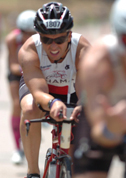
Callahan explains the training aid helps him maintain his focus, keeps his stress down and increases his endurance in trial and depositions – and also when he occasionally swims 2.4 miles, bikes 112 miles and then runs 26.2 miles.
Callahan’s coach inputs his workouts into trainingpeaks.com. Each evening at 7 p.m., Callahan receives an email listing his workout/training schedule for the following two days. “That’s one less thing I have to plan and think about,” he says.
Callahan contends the key to reducing stress is paring down decisions.
“Training is a priority to me. It keeps me sane, relaxed and focused,” Callahan says. “I always have clarity after training. This takes the hassle out of planning daily workouts, keeps me on a schedule and, ultimately, allows me to be more efficient and focused at work.”
He adds, “Training can be a great time to think about cases or just to take a complete break from work. Consistent training builds endurance and strength. It also builds confidence, knowing that there aren’t many lawyers who will outwork me at trial or outlast me at a deposition.”
And while most lawyers interviewed interpreted questions about “gadgets” to mean high technology, some did not.
Luke Gilman, associate in Jackson Walker’s Houston office, defined a “gadget” as “whatever you need to get the job done quicker, easier, more effectively, even just a bit more comfortably.” And even though he worked for a number of years in the field of information technology prior to law school, Gilman has become an “evangelist” for the standing desk. He even has a few converts.
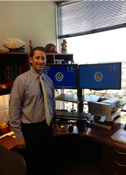
“Human beings just are not meant to sit for as long as lawyers tend to sit,” he points out.
He looked for three requirements in his desk. First, it had to be adjustable, he says, “so I could alternately sit or stand whenever I wanted.” Second, he wanted a desk he could use without having to modify any of the existing furniture in his office. Finally, he wanted a desk that allowed him to use dual monitors.
He selected the Ergotron, which sits on top of his existing desk and required no modifications to the furniture.
“I have two 22-inch monitors mounted on a hydraulic lift, a platform for books and papers, and a lower level for a wireless mouse and keyboard,” he explains. “My summer associate mentee has dubbed it the ‘command center.’”
The set-up, Gilman continues, gives him a greater range of movement and activity throughout the day. That, in turn, “keeps my energy level up, particularly after lunch when it would begin to wane.
His only complaint: The sightline of the monitors is a little lower than he prefers so he has ordered an adjustment kit for taller users.
He’s been using the set-up for about a year now and says he “couldn’t imagine going back to the chair.”
Gilman’s office also contains a “gadget” from the past – an 1891 Bates Automatic Numbering-Machine. “It’s retired, for the most part,” Gilman says, “but it still works just as well as it did the day it came out of the box.”
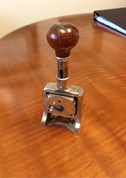
By comparison, the attorney is on his third iPhone – the first two met rather “unexciting but, nevertheless, grisly ends.”
FOOTNOTES
• Depending upon your age, you might remember the 1982 book “Megatrends” by futurist John Naisbitt. He called one of his predicted trends “High tech, high touch,” which discussed the need for balance between technology and human interaction. Naisbitt also revisited the topic in a 1999 book by that title. As the French say, the more things change, the more they stay the same.
• Besides being a smart watch, Pebble holds a record by raising $10.2 million via Kickstarter. Slightly more than a year ago, the company had been rejected by a list of venture capitalists who obviously did not believe if-you-build-it, they-will come. Initial Kickstarter investors put up $99 with the promise of a watch in return. The rest of the story? As of May, the company had raised $15 million, largely thanks to Charles River Ventures. The watches currently sell for $150. Be forewarned: There’s a waiting list.
• Best one liner: Steve Carlin boasts of the two Harvard degrees in his family. Both degrees, however, belong to his wife, Shelley Carlin, of the health law boutique Rogaliner Law Offices. In addition to her J.D., she holds a Master of Public Health.
• Finally, and alas, there is no app for time travel. At least, not yet – although isn’t it likely that Google might be working on it…
Our list obviously is not complete. What’s your favorite tech app or gadget that makes the workaday world more efficient for you? Please email patricia.baldwin@texaslawbook.net.
© 2013 The Texas Lawbook. Content of The Texas Lawbook is controlled and protected by specific licensing agreements with our subscribers and under federal copyright laws. Any distribution of this content without the consent of The Texas Lawbook is prohibited.
If you see any inaccuracy in any article in The Texas Lawbook, please contact us. Our goal is content that is 100% true and accurate. Thank you.
